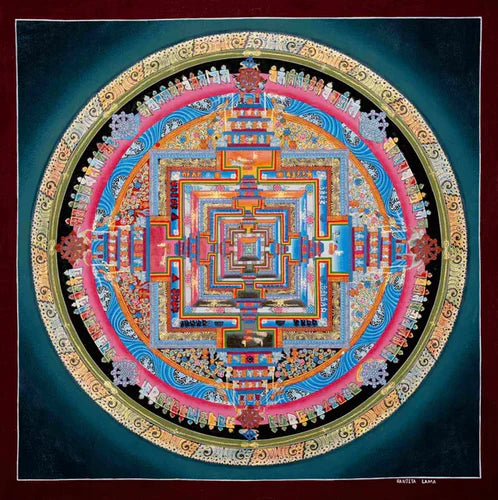
What is Kalachakra Mandala?
Share
Known as the “Wheel of Time” mandala, Kalachakra is highly revered for symbolizing universal peace, balance, and the interconnectedness of all beings. Let's learn everything about this mandala from its origins and central deity to the fascinating process of its creation, its profound spiritual significance, and much more.
Mandala Meaning: An Introduction
The word "mandala" originates from Sanskrit, meaning "circle," and represents a sacred geometric design that captures the universe’s essence. Especially cherished in Buddhism and Hinduism, mandalas are much more than art; they serve as powerful spiritual tools that guide the mind toward focus, self-awareness, and spiritual awakening.
Among these sacred symbols, the Kalachakra Mandala stands out, embodying time, consciousness, and the endless cycles of existence.
What is Kalachakra Mandala?
In the heart of Buddhist tradition, the Kalachakra Mandala is one of the most intricate and significant spiritual representations. Breaking down "Kalachakra" reveals "Kala" (time) and "Chakra" (wheel), a metaphor for the eternal wheel of time governing all beings, whether in physical or spiritual realms.
The Kalachakra Mandala beautifully illustrates the profound connection between the external and internal universes. The external universe encompasses cosmic elements and forces—such as planets, stars, and the natural elements—that lie beyond the self. Meanwhile, the internal universe represents the human body and mind. Within the mandala, these two realms are harmonized, symbolizing the inseparable bond between our inner consciousness and the vast cosmos, highlighting the interconnectedness of all existence.
Because of its intricate design and deep symbolism, it is also regarded as a blueprint for advanced meditation practices, guiding practitioners toward enlightenment.
Kalachakra initiations, often led by a Vajra Master such as the Dalai Lama, involve profound rituals, where practitioners receive blessings through visualizations and mantras associated with the Kalachakra Deity.
Kalachakra Story: Origins and Sacred Legacy
The story of Kalachakra stretches back over a thousand years to teachings believed to have been shared by Buddha Shakyamuni in the 8th century BCE. According to legend, the Buddha introduced the Kalachakra Tantra to the King of Shambhala, a mythical land symbolizing peace and spiritual insight.
Over generations, these teachings spread, uniting all beings in a shared journey toward inner peace. Shambhala represents an enlightened state attainable through a path of compassion and wisdom.
Kalachakra Deity: The Emanation of Buddha Shakyamuni
At the center of the Kalachakra Mandala is the Kalachakra Deity, an emanation of Buddha Shakyamuni. Depicted with multiple arms, legs, and faces, the deity embodies unity, integrating all cosmic energies. Serving as both a guiding spiritual teacher and meditation aid, the Kalachakra deity represents a being who has transcended time, possessing the wisdom to guide others toward enlightenment.
Kalachakra Mandala Art: A Journey Through Sacred Geometry
Though flat on the surface, the Kalachakra Mandala is composed of five levels, each symbolizing various aspects of human and cosmic existence. Each quadrant represents a dimension of the human spirit—body, speech, mind, and action—showing how time and actions affect the cosmos and our lives. Here’s an overview of the layers:
The Mandala of Enlightened Great Bliss
At the heart of the Kalachakra Mandala lies a lotus flower, symbolizing nirvana, or liberation from the cycles of rebirth. In the middle, there's unseen Kalachakra deity with his consort, Vishvamata, surrounded by four other deities. The eight petals signify seats for eight shakti deities, embodying purity and spiritual awakening.
The lotus is significant because it represents purity, spiritual awakening, and the ultimate goal of enlightenment. The mandala's center represents the mind's pure essence and the wisdom that leads to transcending ordinary existence.
Then, in the corners of the floor, lies the Kalachakra's body, speech, mind, and wisdom respectively.
The Mandala of Enlightened Wisdom
Next, just outside the lotus flower, there's 16 supporting pillars with Tathagatas (deities) representing wisdom that supports the roof. The eight red and white lotuses hold sixteen deities known as Tathagatas in yab-yum positions(male and his female consort embracing each on lotus.) This union symbolizes the integration of wisdom (represented by the male aspect) and emptiness (represented by the female aspect), which are essential for achieving enlightenment.
The outer Wisdom Circle, adorned with golden flames and five Dhyani Buddhas, is surrounded by four elemental rings—air, fire, water, and earth—signifying the interconnectedness of all life.
The Mandala of Enlightened Mind
Protected by golden roofs, the Mandala of Enlightened Mind houses 80 deities embodying clarity and consciousness.
In the each corners of outside wall, there's double vajras and the walls are decorated with jeweled borders, pearl garlands, and white lotus petals, representing mental refinement through meditation and understanding.
The Mandala of Enlightened Speech
This mandala, double the size of the Mind Mandala, includes 36 offering goddesses and 80 Yoginis, highlighting the transformative impact of enlightened speech.
It reflects how mindful communication fosters deeper connections and greater understanding.
The Mandala of Enlightened Body
Forming the outermost layer, this expansive mandala features four gates adorned with jewels, goddesses, and protectors. Each gate is supported by elephants, snow lions, and strong men, while the mandala is surrounded by five elements—space, air, fire, water, and earth—symbolizing the unity between internal and external realms.
Kalachakra Mantras and the Noble Eightfold Fath
Engraved within the Kalachakra Mandala are sacred mantras associated with various Bodhisattvas and the Noble Eightfold Path, guiding practitioners toward enlightenment.
Chanting the Kalachakra mantra “Om Ham Ksha Ma La Va Ra Ya Sva Ha” potentially activates protective energies and help practitioners align their minds with higher consciousness. While the Eightfold Path offers a roadmap for ethical and mindful living through right understanding, desire, speech, action, livelihood, effort, mindfulness, and concentration.
Significance of the Kalachakra Mandala
The Kalachakra Mandala holds deep significance in Buddhism, acting as a spiritual map for aligning with the universe. Its intricate design offers a path to protection, inner peace, and wisdom for those who meditate upon it, fostering clarity and purpose. More than a spiritual tool, it symbolizes global peace, inviting all beings to reach their higher consciousness and inspiring individuals toward personal transformation and universal harmony.
Conclusion
More than just a visual masterpiece, the Kalachakra Mandala embodies the essence of time, consciousness, and cosmic harmony. Crafted by skilled artisans in Nepal, at Fine Thanka Art, each mandala captures the sacred symbolism of the "Wheel of Time," ensuring that every detail resonates with its profound significance.
Shop online or visit Fine Thanka Art Gallery today to explore our exquisite collection!
